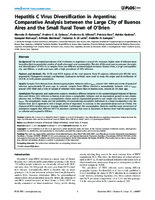Repositorio Digital
Hepatitis C virus diversification in Argentina: comparative analysis between the Large City of Buenos Aires and the small rural town of O'Brien
- DSpace Principal
- →
- Hospital El Cruce
- →
- Publicaciones
- →
- Artículos
- →
- Ver ítem
JavaScript is disabled for your browser. Some features of this site may not work without it.
Mostrar el registro sencillo del ítem
| dc.contributor.author | Golemba, Marcelo | |
| dc.contributor.author | Culasso, Andrés | |
| dc.contributor.author | Villamil, Federico | |
| dc.contributor.author | Bare, Patricia | |
| dc.contributor.author | Gadano, Adrián | |
| dc.contributor.author | Ridruejo, Ezequiel | |
| dc.contributor.author | Martinez, Alfredo | |
| dc.contributor.author | Di Lello, Federico | |
| dc.contributor.author | Campos, Rodolfo | |
| dc.date.accessioned | 2016-01-26T17:09:31Z | |
| dc.date.available | 2016-01-26T17:09:31Z | |
| dc.date.issued | 2013 | |
| dc.identifier.citation | Golemba MD, Culasso ACA, Villamil FG, Bare P, Gadano A, Ridruejo E, et al. (2013) Hepatitis C Virus Diversification in Argentina: Comparative Analysis between the Large City of Buenos Aires and the Small Rural Town of O'Brien. PLoS ONE 8(12): e84007. doi:10.1371/journal.pone.0084007 | es_AR |
| dc.identifier.issn | 1932-6203 | |
| dc.identifier.uri | https://journals.plos.org/plosone/article/authors?id=10.1371/journal.pone.0084007 | es |
| dc.identifier.uri | http://hdl.handle.net/123456789/200 | es |
| dc.description | Fil: Villamil, F. Hospital de Alta Complejidad en Red El Cruce Dr. Néstor C. Kirchner. Unidad de Trasplante Hepático. Florencio Varela, Argentina. | es_AR |
| dc.description.abstract | Background The estimated prevalence of HCV infection in Argentina is around 2%. However, higher rates of infection have been described in population studies of small urban and rural communities. The aim of this work was to compare the origin and diversification of HCV-1b in samples from two different epidemiological scenarios: Buenos Aires, a large cosmopolitan city, and O'Brien, a small rural town with a high prevalence of HCV infection. Patients and Methods The E1/E2 and NS5B regions of the viral genome from 83 patients infected with HCV-1b were sequenced. Phylogenetic analysis and Bayesian Coalescent methods were used to study the origin and diversification of HCV-1b in both patient populations. Results Samples from Buenos Aires showed a polyphyletic behavior with a tMRCA around 1887–1900 and a time of spread of infection approximately 60 years ago. In contrast, samples from ÓBrien showed a monophyletic behavior with a tMRCA around 1950–1960 and a time of spread of infection more recent than in Buenos Aires, around 20–30 years ago. Conclusion Phylogenetic and coalescence analysis revealed a different behavior in the epidemiological histories of Buenos Aires and ÓBrien. HCV infection in Buenos Aires shows a polyphyletic behavior and an exponential growth in two phases, whereas that in O'Brien shows a monophyletic cluster and an exponential growth in one single step with a more recent tMRCA. The polyphyletic origin and the probability of encountering susceptible individuals in a large cosmopolitan city like Buenos Aires are in agreement with a longer period of expansion. In contrast, in less populated areas such as O'Brien, the chances of HCV transmission are strongly restricted. Furthermore, the monophyletic character and the most recent time of emergence suggest that different HCV-1b ancestors (variants) that were in expansion in Buenos Aires had the opportunity to colonize and expand in O’Brien | es_AR |
| dc.language.iso | en_US | es_AR |
| dc.publisher | Public Library of Science (PLOS) | es_AR |
| dc.subject | Hepatitis C | es_AR |
| dc.subject | Análisis Demográfico | es_AR |
| dc.subject | Argentina | es_AR |
| dc.subject | Dinámica de Población | es_AR |
| dc.title | Hepatitis C virus diversification in Argentina: comparative analysis between the Large City of Buenos Aires and the small rural town of O'Brien | es_AR |
| dc.type | Article | es_AR |
Ficheros en el ítem
Este ítem aparece en la(s) siguiente(s) colección(ones)
-
Artículos
Articles

